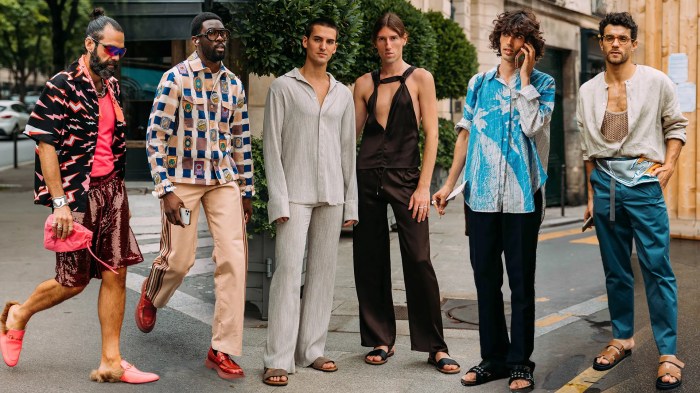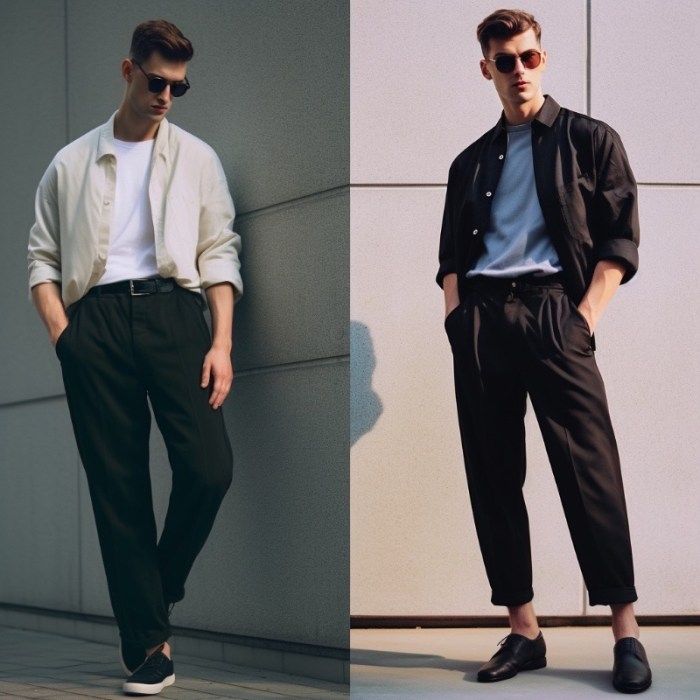Crazy Mens Fashion A Bold History
Defining “Crazy” Men’s Fashion
Crazy men’s fashion – The term “crazy” in men’s fashion is inherently subjective, fluctuating across eras, cultures, and individual perspectives. What one person considers outrageous, another might find stylish or even commonplace. This spectrum encompasses a wide range of stylistic choices, from bold color combinations and unconventional silhouettes to avant-garde textile choices and the playful juxtaposition of disparate elements. The perception of “crazy” is heavily influenced by prevailing social norms, cultural trends, and the individual’s personal aesthetic sensibilities.
Examples of “Crazy” Fashion Across Eras and Cultures
Throughout history, men’s fashion has seen periods of significant experimentation. The flamboyant styles of the French aristocracy in the 1700s, characterized by elaborate lace, powdered wigs, and high-heeled shoes, were considered daring for their time. Similarly, the Edwardian era’s penchant for sharply tailored suits and extravagant accessories, like monocles and top hats, represented a specific form of “crazy” for its societal context.
In contrast, the adoption of brightly colored fabrics and loose-fitting clothing in certain sub-Saharan African cultures represents a different expression of unconventional menswear, reflecting unique cultural aesthetics and traditions.
Evolution of Unconventional Menswear
What was once considered shocking or unconventional often becomes integrated into mainstream fashion. The rise of denim jeans, initially workwear, to a global fashion staple illustrates this transition. Similarly, the adoption of previously feminine garments like scarves and jewelry by men has significantly broadened the definition of masculine attire. The evolution reflects a gradual shift in societal norms and acceptance of diverse expressions of masculinity.
Historical Context: Crazy Fashion Moments
Several historical periods stand out for their groundbreaking menswear styles. Analyzing these periods reveals the interplay between social change, artistic movements, and the evolution of fashion.
Three Significant Periods of Boundary-Pushing Menswear
The three periods examined here are the 1920s, the 1970s, and the 1980s, each showcasing unique expressions of “crazy” fashion driven by distinct social and cultural factors. The 1920s saw a rejection of the Edwardian era’s formality with looser silhouettes, dropped waistlines, and the rise of bolder colors. The 1970s disco era embraced flamboyant styles, while the 1980s New Romantic movement introduced a more theatrical and androgynous aesthetic.
Comparison of 1970s Disco and 1980s New Romantic Menswear
A direct comparison highlights the contrasting yet equally unconventional approaches to menswear during these decades.
| Feature | 1970s Disco | 1980s New Romantic |
|---|---|---|
| Silhouette | Close-fitting, often flamboyant and showy | More fluid, layered, and often theatrical |
| Color Palette | Bright, bold colors, metallics | Often darker, dramatic colors, with occasional bright accents |
| Key Elements | Wide-collared shirts, platform shoes, flared pants, flashy jewelry | Frilly shirts, lace, dramatic makeup, oversized coats |
| Overall Aesthetic | Glamorous, energetic, and overtly masculine | Romantic, theatrical, and sometimes androgynous |
Menswear Designers Known for Unconventional Elements
Several designers have consistently challenged conventional menswear norms. Jean Paul Gaultier’s work frequently incorporates provocative elements and gender-bending designs. Alexander McQueen’s collections were known for their dramatic silhouettes and theatrical presentations. Rei Kawakubo of Comme des Garçons consistently pushes boundaries with deconstructed and avant-garde designs. These designers have significantly influenced the landscape of “crazy” menswear, inspiring future generations of designers and challenging perceptions of what constitutes masculine attire.
Modern Interpretations of “Crazy” Menswear
Contemporary “crazy” menswear is significantly shaped by the influence of various subcultures and evolving social attitudes. The following sections will explore these influences and provide examples of current trends.
Influence of Subcultures on Modern Menswear
Subcultures like punk, goth, and hip-hop have profoundly impacted the evolution of “crazy” menswear. Punk’s rebellious spirit manifested in ripped clothing, safety pins, and DIY aesthetics. Goth embraced dark colors, dramatic makeup, and layered clothing. Hip-hop introduced streetwear elements, bold graphics, and oversized silhouettes. These subcultures continue to inspire contemporary designers and inform the stylistic choices of individuals embracing unconventional fashion.
Current “Crazy” Menswear Trends
Several current trends could be considered “crazy” in their departure from traditional menswear norms.
- Gender-bending fashion: The blurring of lines between traditionally masculine and feminine garments, such as men wearing skirts or dresses.
- Upcycled and sustainable fashion: Incorporating recycled or repurposed materials into clothing designs, reflecting an environmentally conscious approach to fashion.
- Oversized silhouettes: Exaggerated proportions and voluminous shapes in clothing, often contrasting with more tailored fits.
- Bold color combinations: Unexpected and vibrant color pairings that challenge traditional notions of masculine color palettes.
- Statement accessories: Large, eye-catching accessories that serve as focal points of an outfit, such as oversized jewelry or unique headwear.
Hypothetical “Crazy” Menswear Runway Show
A hypothetical runway show featuring “crazy” outfits would showcase a diverse range of styles and concepts.
- Outfit 1: A deconstructed suit made from recycled denim, featuring mismatched textures and oversized lapels, paired with brightly colored platform boots.
- Outfit 2: A flowing, floor-length gown in vibrant shades of purple and orange, made from a luxurious silk fabric, accessorized with intricate silver jewelry.
- Outfit 3: A patchwork ensemble combining various fabrics and patterns, including leather, tweed, and floral prints, showcasing a bold mix of textures and colors.
- Outfit 4: A futuristic-looking jumpsuit crafted from metallic fabrics, with geometric patterns and glowing LED accents, accessorized with futuristic-style headwear.
The Psychology of “Crazy” Fashion Choices
The reasons behind unconventional fashion choices are multifaceted, encompassing self-expression, risk-taking, and social commentary.
Reasons for Unconventional Fashion Choices, Crazy men’s fashion
Men might choose unconventional fashion to express their individuality, challenge societal norms, or make a statement about their beliefs or values. It can be a way to stand out from the crowd, showcase creativity, or explore different aspects of their identity. The choice is often a reflection of their personal values and how they wish to present themselves to the world.
Risk-Taking and Self-Expression
The willingness to embrace unconventional fashion often correlates with a higher level of risk-taking. This risk-taking can be a powerful form of self-expression, allowing individuals to push boundaries and challenge societal expectations. The act of wearing something considered “crazy” can be a statement of confidence and self-acceptance.
Social Context and Acceptance of “Crazy” Fashion
The perception and acceptance of “crazy” fashion are heavily influenced by social context. What might be considered acceptable in a subcultural setting could be deemed inappropriate in a more formal environment. The social context shapes the individual’s willingness to embrace unconventional styles and the reactions they might encounter from others.
The Impact of Media and Social Influence

Source: vogue.com
Media plays a significant role in shaping perceptions and trends related to “crazy” menswear. Social media influencers and traditional media outlets influence both the normalization and stigmatization of unconventional styles.
Role of Social Media Influencers and Celebrities
Social media influencers and celebrities often set trends by showcasing unconventional styles. Their endorsements can significantly influence public perception, leading to wider adoption or rejection of particular styles. The visibility and reach of these influencers amplify the impact of their fashion choices.
Media’s Contribution to Normalization or Stigmatization
Fashion magazines and other media outlets can either normalize or stigmatize unconventional styles. Positive portrayal in mainstream media can lead to wider acceptance, while negative or critical coverage can reinforce societal biases against such styles. The media’s representation significantly shapes public opinion and influences consumer behavior.
Men’s fashion can certainly be adventurous, sometimes bordering on the eccentric. One could argue that the resurgence of certain styles pushes the boundaries of what’s considered conventionally stylish. However, a surprisingly versatile and stylish option within this spectrum is the practical yet fashionable realm of mens coveralls fashion , offering a unique blend of functionality and flair.
Ultimately, the definition of “crazy” in men’s fashion remains subjective, but coveralls definitely offer a bold statement.
Visual Representation of a “Crazy” Fashion Trend’s Spread
Imagine a social media post showcasing a brightly colored, oversized puffer jacket with mismatched patterns. The image is a close-up, highlighting the texture and color combinations. The post is shared widely, leading to similar jackets appearing in other social media posts, fashion blogs, and ultimately, in retail stores. The key visual elements are the jacket’s bold colors and unconventional patterns, which become instantly recognizable and easily replicated.
The Future of “Crazy” Men’s Fashion

Source: thefashionisto.com
Predicting future trends is inherently speculative, but observing current trends and technological advancements offers clues about potential directions.
Potential Future Trends in “Crazy” Menswear
Future trends might include even more pronounced gender fluidity, increased use of sustainable and ethically sourced materials, and the integration of technology into clothing. We might see personalized, digitally-printed garments reflecting individual tastes and expressions. The use of bioluminescent fabrics or garments that change color based on body temperature are also potential possibilities.
Hypothetical “Crazy” Menswear Collection for 2030
A hypothetical “crazy” menswear collection for 2030 might feature garments crafted from bio-engineered materials, incorporating self-healing fabrics and temperature-regulating technologies. Silhouettes could be fluid and adaptable, changing shape based on the wearer’s movement or environment. The overall aesthetic would be futuristic yet sustainable, reflecting a balance between technological advancement and environmental consciousness.
Technological Advancements’ Influence on “Crazy” Menswear
Technological advancements will undoubtedly shape the future of “crazy” menswear. 3D printing, smart fabrics, and personalized customization options will empower designers and individuals to create truly unique and unconventional garments. These advancements will blur the lines between fashion, technology, and personal expression, leading to a new era of creative exploration in menswear.
FAQ Explained: Crazy Men’s Fashion
What are some common misconceptions about “crazy” men’s fashion?
One common misconception is that “crazy” fashion is always attention-seeking or lacking in sophistication. Many unconventional styles are carefully considered and demonstrate a high level of creativity and artistic expression.
How can men incorporate elements of “crazy” fashion into their everyday wardrobe without looking overly outlandish?
Start with small, subtle changes. A unique accessory, an unexpected color combination, or a slightly unconventional cut can add a touch of “crazy” without being overwhelming. Confidence is key – wearing something unusual with assurance makes all the difference.
Is there a specific age group or personality type most associated with “crazy” men’s fashion?
No, “crazy” men’s fashion transcends age and personality types. Individuals from all walks of life express themselves through unconventional styles, demonstrating the broad appeal and diverse interpretations of this aesthetic.





















